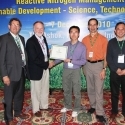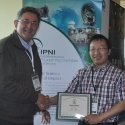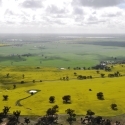01 Mar 2017
Potassium for fodder quality – 2016
Results of a field trial at Bessiebelle, Victoria
 Inspecting K responses in dairy pastures
Inspecting K responses in dairy pastures
Pasture responses to applied K in the dairy industry are reasonably common, but with the increase in the use of bought-in feed, many paddocks are at luxury levels, especially in close proximity to the dairy shed. N use on dairy pastures is common but there is less attention – in general – paid to paddocks that will be grazed then closed for fodder conservation. Those conserved fodder paddocks are often “out-paddocks” or paddocks leased or even from adjacent dry-land mixed farming regions. This experiment aims to assess the impact of N and K – at two rates each on the spring growth of pastures, and then to assess the effect of this nutrition on fodder quality. The magnesium treatment is imposed because of the decline in fodder Mg when K is applied, and low Mg in fodder can lead to hypomagnesia in dairy cows.
To address this a small field experiment was undertaken at Bessiebelle in the Victorian south west. The pasture was a mixed sward of perennial ryegrass and subterranean clover. Nutrient treatments applied were four rates of K as MOP (0, 25, 50, 100 kg/ha), two rates of N (0 and 50 kg/ha) and the high N rates were split for two rates of magnesium (0, 10 kg/ha). Two pasture cuts were taken in the late spring and biomass measured. Nutrient composition and also fodder quality assessments are being undertaken but these data are not yet to hand.
There were significant responses to K and N at this site, with about a 10% biomass response (0.4 t/ha) to K (p=0.039) for the 25 kg K/ha rate, but no significant response at the higher rates of K. There was also a significant response to N (p=0.018), from 4.19 to 4.75 t/ha of biomass. Even though it Figure 1 would otherwise, there was no interaction between N and K in this experiment, so that the response to K followed the same pattern at low and high N supply. It would be tempting to suggest that the 25 kg K/ha was N limited as shown by difference between the N treatments at that rate – but the statistics are not strong, and there were no pasture composition differences noted that would suggest the N limitation.
Figure 1, The biomass (kg DM/ha) response of a sub-clover/ryegrass pasture to four rates of K at two rates on N at Bessiebelle, Victoria, 2016. Data presented is the sum of cuts on November 7 and November 22. The error bars are indicated on the graph.
There was a significant difference (p=0.042) to added Mg at the first cut (November 07) but not at the later cut or when the two cuts were combined. The added Mg increased the mean biomass from 4.36 t DM/ha to 4.64 t DM/ha.
The results for this field trial adds to our knowledge of K responses on dairy pastures, and indicates that co-limitation of nutrients can occur - in this case N and K, with the responses to K enhanced by ensuring adequate N is supplied.





